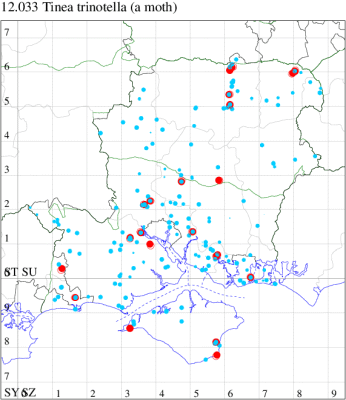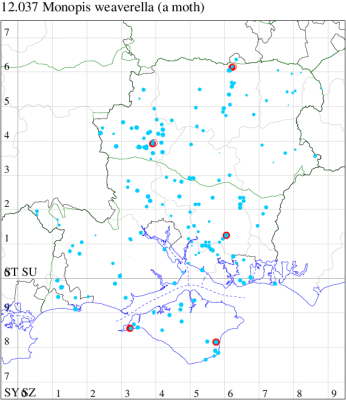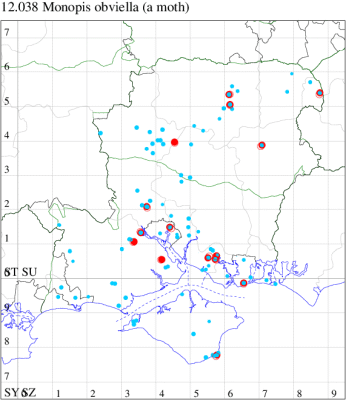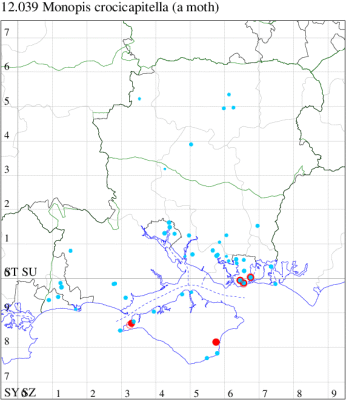2020 Annual Report for: Tineidae / Tineinae
For species seen in 2020 that had less than or equal to 100 records, full details are included; for more common species, the earliest, latest and highest count by vice-county are shown. The narrative for each species is taken from the main Hantsmoths website, and it is possible that some information on abundance and occurrence can get out of date, as it is impossible to keep up with all changes; however it should give a good introduction to each species. The tables in each species account summarise the previous status, and that for the current year.
For the maps, all records prior to 2020 are shown by a blue dot (the larger the dot, the more recent), with the current year's records shown in red. As previous records are superimposed on any report for 2020, new sites have greater emphasis (i.e. will show as 'more red').
In the species accounts, an asterisk next to a location indicates a new 10km square record; earliest ever dates are highlighted in orange, and latest ever in red. Initials in the species accounts refer to the recorders listed here. Please get in touch if you identify any omissions or errors, in particular if you have records that have yet to be submitted. Details of how to submit records can be found here.
12.026 [B&F: 0236] Common Clothes Moth Tineola bisselliella (Hummel, 1823) - Local
Local in houses and farm buildings throughout the British Isles. In Hampshire and on the Isle of Wight formerly the most abundant clothes moth, but now outnumbered by Case-bearing Clothes Moth Tinea pellionella. Wingspan 9-16 mm. Characterised by reddish ochreous head and pale buff, unmarked forewings. Larva feeds on woollen materials, animal fur, feathers in bird nests and insect collections, living within a silken tube or tent, causing sufficient damage to be a serious pest in some areas.
Records prior to 2020
| Vice County | #Records | #Individuals | First Record | Last Record |
|---|---|---|---|---|
| 10 | 4 | 3 | 1929 | 2016 |
| 11 | 84 | 202 | 1975 | 2019 |
| 12 | 5 | 3 | 2002 | 2018 |
2020 records
| Vice County | #Records | #Individuals | Max Quantity |
|---|---|---|---|
| 11 | 8 | 8 | 1 |

Records by year
Records by week (adult)
Records by week (larval)
Record Details
VC11: Southampton*, one, to actinic, 23 Jun (MGP); Southsea, one, 27 May (JGe); one, 19 May; one, 26 May; one, 27 May; one, 29 May; one, 30 May; one, 02 Jun (JRL);
VC12: Alton, six, 24 Jun (EFig)
12.027 [B&F: 0240] Case-bearing Clothes Moth Tinea pellionella Linnaeus, 1758 - Local
Local in houses, bird nests, barns, warehouses and granaries throughout the British Isles. In Hampshire and on the Isle of Wight sparsely distributed but widespread. Wingspan 9-16 mm. Probably the commonest tineid clothes moth, but cannot always be reliably separated from T. translucens or T. dubiella without dissection of the genitalia. Larva feeds on woollen materials, fur, feathers, hair, owl pellets and stored goods, living within a silken case, causing sufficient damage to be a serious pest in some areas.
Records prior to 2020
| Vice County | #Records | #Individuals | First Record | Last Record |
|---|---|---|---|---|
| 10 | 52 | 225 | 1893 | 2019 |
| 11 | 348 | 556 | 1974 | 2019 |
| 12 | 165 | 233 | 1997 | 2019 |
2020 records
| Vice County | #Records | #Individuals | Max Quantity |
|---|---|---|---|
| 10 | 7 | 11 | 3 |
| 11 | 7 | 6 | 1 |
| 12 | 5 | 4 | 1 |

Records by year
Records by week (adult)
Records by week (larval)
Record Details
VC10: Shanklin, larva, three, indoors, 14 May; one, indoors, gen det, 20 May; larva, one, indoors, 24 May; larva, one, indoors, 04 Jun; one, indoors, gen det, 08 Jun; three, indoors, gen det, 29 Jun (IOu); Seaview, one, field observation, 17 Jul (JMas);
VC11: Woodlands, New Forest, present, field observation, 08 Mar (RBW); Romsey, one, 14 Aug (MB); Southampton, one, to actinic, 03 May (MGP); Bitterne, one, indoors, 22 May (PAB); Eastleigh, one, to actinic, 03 May (KArb); Winchester, one, 27 Jun (THW); Tuckton, Bournemouth, one, 12 Jul (APar); Southsea, one, 26 May (JRL);
VC12: Harestock, two, indoors, 11 Jun (GRog); Bullington*, one, to actinic, 20 Sep (GCE); Axmansford*, present, indoors, 08 Aug (ACB); Liss Forest*, one, indoors, 01 Apr; one, indoors, 20 May (RJM); Farnborough, one, field observation, 27 Apr (KBW)
12.032 [B&F: 0246] Tinea semifulvella Haworth, 1828 - Common
Common in bird nests throughout much of Britain and Ireland. In Hampshire recorded widely throughout, and on the Isle of Wight, after being historically rare, increased recording activity in the 21st century has revealed its true status as being equally widespread. Systematic collection of old bird-nests during the winter months would likely result in many more records of this and other related species. Wingspan 14-22 mm. Resembles T. trinotella, which see for differences. Larva feeds on detritus in bird nests and sheep's wool.
Records prior to 2020
| Vice County | #Records | #Individuals | First Record | Last Record |
|---|---|---|---|---|
| 10 | 91 | 106 | 1900 | 2019 |
| 11 | 290 | 286 | 1973 | 2019 |
| 12 | 83 | 87 | 1976 | 2019 |
2020 records
| Vice County | #Records | #Individuals | Max Quantity |
|---|---|---|---|
| 10 | 12 | 12 | 2 |
| 11 | 4 | 4 | 1 |
| 12 | 2 | 2 | 1 |

Records by year
Records by week (adult)
Records by week (larval)
Record Details
VC10: West High Down Quarry, one, 07 Aug (IOu); Freshwater, one, to actinic, 19 Sep (PBa); Cranmore, present, to actinic, 11 Sep (CHic); St Lawrence Undercliff, one, to actinic, 28 Sep (PBa); Bonchurch, one, 08 Jun; one, 15 Jun; one, 17 Jun; two, 19 Jun (JHa); Shanklin, one, 06 Jul; one, 26 Aug; one, 28 Sep; one, 07 Oct (IOu);
VC11: Romsey, one, 26 May (NRJ); Kings Somborne, one, to actinic, 11 Jun (GCE); Southampton, one, 22 Jul (MEdg); Portsmouth, one, 01 Jun (IRT); Stroud, Petersfield*, one, to actinic, 07 Oct (RAll);
VC12: Crawley, one, to actinic, 17 Sep (GCE); Cheriton, one, to actinic, 24 Jun (DAS); Liss*, one, 17 Jul; five, 24 Jul; two, 31 Jul (LBe)
12.033 [B&F: 0247] Tinea trinotella Thunberg, 1794 - Common
Common in bird nests throughout Britain and Ireland. In Hampshire common and widespread, but apparently very uncommon on the Isle of Wight. Wingspan 11-17 mm. Resembles T. semifulvella, but the head is not mottled with dark brown (MBGBI Vol 2). Larva feeds on detritus in bird nests.
Records prior to 2020
| Vice County | #Records | #Individuals | First Record | Last Record |
|---|---|---|---|---|
| 10 | 34 | 33 | 1900 | 2019 |
| 11 | 729 | 774 | 1971 | 2019 |
| 12 | 220 | 284 | 1980 | 2019 |
2020 records
| Vice County | #Records | #Individuals | Max Quantity |
|---|---|---|---|
| 10 | 4 | 4 | 1 |
| 11 | 26 | 26 | 2 |
| 12 | 12 | 13 | 2 |

Records by year
Records by week (adult)
Records by week (larval)
Record Details
VC10: West High Down Quarry, one, 07 Aug (IOu); Bonchurch, one, 21 May; one, 27 May (JHa); Shanklin, one, 09 Aug (IOu);
VC11: Brockwood, one, 27 May (SDut); Marchwood, one, 07 May; one, 30 May (CTh); Woodlands, New Forest, present, 02 Jun (RBW); Totton, one, 08 Apr; one, 02 Jun; two, 06 Aug (LH); Romsey, one, 02 Jun (SLay); one, 08 Jul (NRJ); Winchester, one, 26 May; one, 09 Jun; one, 17 Jul; one, 31 Jul; one, 07 Aug (THW); Fareham, one, to actinic, 01 Jun; one, to actinic, 02 Jul; one, to actinic, 21 Jul; one, to actinic, 01 Aug; one, to actinic, 09 Aug (MLO); one, 07 May (RJD); Botley, one, to actinic, 27 Jul; one, to actinic, 09 Aug (SLB); Portsmouth, one, 24 Jul; one, 12 Aug (IRT); Lovedean, one, 09 May (ARJ); Burton, nr Christchurch, one, 12 Jun (JSw); Sway, one, 31 May (SKe);
VC12: Cholderton, one, 08 Aug (TJN, HE); Anna Valley, Andover, one, 21 May; one, 30 Jul (TJN); Harestock, one, to actinic, 22 Jul; one, to actinic, 08 Aug; one, to actinic, 16 Aug (GRog); Cheriton, one, to actinic, 10 Aug (DAS); Basingstoke, two, 08 May; one, 27 May; one, 01 Jun; one, 31 Jul (MJW); one, 19 May; one, 20 May; one, 24 Jun; one, 16 Jul (RHil); Pamber Forest, one, 14 Sep; one, 07 May; one, 10 Aug (GJD); Castle Bottom NNR, one, 25 Jun (JHH, AMD); Yateley, two, 03 May; one, 09 May; one, 07 Aug; one, 21 May (JHH)
12.034 [B&F: 0237] Brown-dotted Clothes Moth Niditinea fuscella (Linnaeus, 1758) - Local
Local found indoors and in chicken-houses and out-buildings throughout much of the British Isles, less numerous in the north. In Hampshire and on the Isle of Wight unlike Tineola bisselliella, locally common on the mainland, with the first Isle of Wight records in 1999. Wingspan 11-17 mm. Haplotinea species have the forewing with very indistinct stigmata; N. striolella
Records prior to 2020
| Vice County | #Records | #Individuals | First Record | Last Record |
|---|---|---|---|---|
| 10 | 3 | 3 | 1999 | 2005 |
| 11 | 128 | 154 | 1980 | 2019 |
| 12 | 31 | 40 | 1996 | 2019 |
2020 records
| Vice County | #Records | #Individuals | Max Quantity |
|---|---|---|---|
| 11 | 1 | 1 | 1 |

Records by year
Records by week (adult)
Records by week (larval)
Record Details
VC11: Totton*, one, field observation, 30 Nov (TRa)
12.036 [B&F: 0227] Skin Moth Monopis laevigella ([Denis & Schiffermüller], 1775) - Common
Common in and around bird nests and farm buildings throughout the British Isles and on sea cliffs on St Kilda. In Hampshire probably common but under-recorded throughout, and increased recording activity on the Isle of Wight in recent years has revealed it to be widespread. Wingspan 13-20 mm. Similar to M. obviella, but lateral dark margin of head wider (MBGBI Vol 2). Larva feeds on dead animals, animal waste, owl pellets, detritus in bird nests and bird guano, living within a silken tube or tent.
Records prior to 2020
| Vice County | #Records | #Individuals | First Record | Last Record |
|---|---|---|---|---|
| 10 | 66 | 86 | 1900 | 2019 |
| 11 | 365 | 389 | 1972 | 2019 |
| 12 | 40 | 49 | 1977 | 2019 |
2020 records
| Vice County | #Records | #Individuals | Max Quantity |
|---|---|---|---|
| 10 | 3 | 2 | 1 |
| 11 | 5 | 5 | 1 |

Records by year
Records by week (adult)
Records by week (larval)
Record Details
VC10: Cranmore, present, to actinic, 01 Aug (CHic); Haseley Manor, one, 11 Aug; Shanklin, one, 21 May (IOu);
VC11: Kings Somborne, one, to actinic, 21 May (GCE); Winchester, one, indoors, 13 Jul; one, 14 Sep (THW); Fareham, one, to actinic, 15 Aug; one, to actinic, 21 Sep (MLO)
12.037 [B&F: 0228] Monopis weaverella (Scott, 1858) - Common
Common in a wide range of habitats throughout Britain, more numerous in the north. Scattered records from Hampshire and the Isle of Wight. Wingspan 13-18 mm. Very similar to Skin Moth M. laevigella, and some of the criteria quoted for the separation of the two species are of limited use when confronted with a single specimen in isolation. Larva feeds on dead animals and animal waste, often in bird nests.
Records prior to 2020
| Vice County | #Records | #Individuals | First Record | Last Record |
|---|---|---|---|---|
| 10 | 30 | 40 | 1900 | 2019 |
| 11 | 302 | 358 | 1979 | 2019 |
| 12 | 172 | 204 | 1994 | 2019 |
2020 records
| Vice County | #Records | #Individuals | Max Quantity |
|---|---|---|---|
| 10 | 5 | 21 | 10 |
| 11 | 1 | 1 | 1 |
| 12 | 4 | 4 | 1 |

Records by year
Records by week (adult)
Records by week (larval)
Record Details
VC10: West High Down Quarry, 10, 07 Aug; two, 20 Aug; Shanklin, six, 14 Aug; one, 17 Aug; two, 20 Aug (IOu);
VC11: Wickham, one, 17 May (JRDS); West Walk, one, 14 Aug (MLO);
VC12: Cholderton, one, 08 Aug (TJN, HE); Chilbolton, one, to actinic, 02 Aug (GCE); Pamber Forest, one, 18 May; one, 20 May; one, 31 Jul (GJD)
12.038 [B&F: 0229] Monopis obviella ([Denis & Schiffermüller], 1775) - Local
Local in barns, warehouses and granaries throughout much of southern Britain, with records north to southern Scotland. In Hampshire and on the Isle of Wight widespread and reasonably common in the south of the county. Wingspan 10-13 mm. Similar to M. crocicapitella, which see for differences. Larva feeds on woollen materials and refuse, and detritus in bird nests.
Records prior to 2020
| Vice County | #Records | #Individuals | First Record | Last Record |
|---|---|---|---|---|
| 10 | 68 | 78 | 1900 | 2019 |
| 11 | 266 | 340 | 1974 | 2019 |
| 12 | 99 | 114 | 1980 | 2019 |
2020 records
| Vice County | #Records | #Individuals | Max Quantity |
|---|---|---|---|
| 10 | 5 | 6 | 2 |
| 11 | 33 | 46 | 4 |
| 12 | 11 | 13 | 2 |

Records by year
Records by week (adult)
Records by week (larval)
Record Details
VC10: Bonchurch, one, 09 May; one, 25 May; one, 26 May; two, 02 Jun; one, 08 Jun (JHa);
VC11: Ashurst, NF, one, 27 May (SAB); Totton, one, 10 Apr; one, 22 Apr; one, 02 May; one, 18 May; one, 20 May; one, 24 May; two, 25 May; two, 26 May; one, 02 Jun; one, 07 Jun; two, 08 Jun; two, 13 Jun; one, 01 Jul; one, 02 Jul; two, 17 Jul; one, 24 Jul; four, 09 Aug; two, 11 Aug; one, 20 Aug; two, 07 Sep; one, 13 Sep; one, 14 Sep; one, 19 Sep; two, 20 Sep (LH); Romsey, one, 01 Jun (MB); Dibden Purlieu, one, to actinic, 08 Aug (RAC); Southampton, one, to actinic, 27 May (MGP); Catisfield, one, 10 Aug (ALR); Fareham, two, 29 Sep (IMcP); one, to actinic, 02 Jun; one, to actinic, 20 Aug (MLO); Southsea, two, 22 Apr (JRL);
VC12: Cholderton, one, 31 Jul (TJN, HE); Barton Stacey, one, to actinic, 22 Jun (GCE); Basingstoke, one, 06 Apr (MJW); one, 19 May; one, 20 May; one, 24 Jun (RHil); Alton, one, to actinic, 09 Apr (DBO); Farnborough, two, 26 May; one, 02 Jun; two, 25 Jun; one, 17 Jul; one, 02 Sep (KBW)
12.039 [B&F: 0230] Monopis crocicapitella (Clemens, 1859) - Local
Local and occasionally numerous around areas with flour, cereals, natural fibres and captive birds such as poultry and doves. More restricted than M. obviella, in maritime areas as far north as Yorkshire and especially in the south-west and Ireland. In Hampshire and on the Isle of Wight frequent only in the south-east of the county. Wingspan 10-16 mm. Very similar to M. obviella, which has the forewing with a pale yellow, not ochreous, dorsal streak and pale irroration limited to a sprinkling of whitish scales near costa; also, the hindwing of M. obviella is dark fuscous, not pale grey (MBGBI Vol 2). Larva feeds on detritus in bird nests, dry vegetable matter and similar.
According to posts on lepiforum.org. the two species are diagnosable based on external characteristics:
Monopis obviella : hind margin of the forewings and forehead crest golden yellow, shiny. 10-12 mm; basic colour of the forewings not very variable, usually quite dark brown.
Monopis crocicapitella : hind margin of the forewings and forehead crest cream to light brown. 12-16 mm; ground colour of the forewings not very variable, usually much lighter than in Monopis obviella .
The two species are actually easy to separate: M. crocicapitella has a more extensive yellow color on the forewing, with yellow fringes and often more or less yellow scales on the costal margin. The black is duller and less clearly defined.
Records prior to 2020
| Vice County | #Records | #Individuals | First Record | Last Record |
|---|---|---|---|---|
| 10 | 10 | 7 | 1924 | 2018 |
| 11 | 543 | 622 | 1974 | 2019 |
| 12 | 7 | 7 | 1996 | 2011 |
2020 records
| Vice County | #Records | #Individuals | Max Quantity |
|---|---|---|---|
| 10 | 2 | 2 | 1 |
| 11 | 19 | 21 | 2 |

Records by year
Records by week (adult)
Records by week (larval)
Record Details
VC10: Totland, one, 20 Sep (RTe); Shanklin, one, gen det, 20 Sep (IOu);
VC11: Southampton, one, 09 May (MEdg); Portsmouth, one, 09 May; one, 17 May; one, 19 May; two, 24 May; one, 26 May; one, 08 Aug; one, 15 Sep; two, 28 Sep (IRT); Sway, one, 25 Jun (SKe); Southsea, one, 10 May; one, 23 May; one, 03 Jun; one, 12 Sep; one, 08 Oct (JGe); one, 19 May; one, 25 May; one, 26 May; one, 27 May; one, 02 Jun; one, 20 Nov (JRL)
12.040 [B&F: 0231] Monopis imella (Hübner, [1813]) - Nationally Scarce B
Nationally scarce (Nb) in Britain as far north as Morayshire, most common near the sea and found more in wild habitats than other British species of the genus. In Hampshire more or less restricted to the coast to the east of Southampton, with no recent records in the north of the county or on the Isle of Wight. Wingspan 11-14 mm. Larva feeds on sheep's wool, dead animals and detritus in bird nests.
Records prior to 2020
| Vice County | #Records | #Individuals | First Record | Last Record |
|---|---|---|---|---|
| 10 | 1 | 0 | 1959 | 1959 |
| 11 | 39 | 41 | 1982 | 2019 |
2020 records
| Vice County | #Records | #Individuals | Max Quantity |
|---|---|---|---|
| 11 | 3 | 3 | 1 |

Records by year
Records by week (adult)
Records by week (larval)
Record Details
VC11: Portsmouth, one, 13 Aug; one, 18 Aug; one, 26 Aug (IRT)